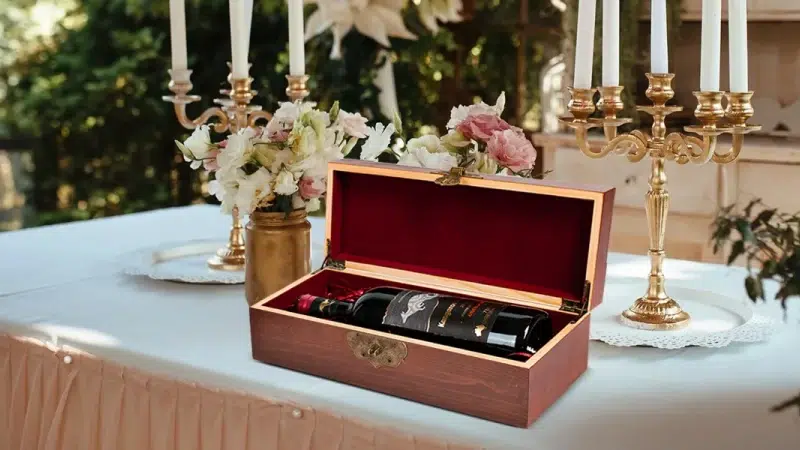
A well-designed wine box shouldn’t be thrown away—it should be treasured.
To make a wine box reusable, every design decision must serve both presentation and longevity: premium materials, versatile form, and elegant subtlety.
Over the years, I’ve worked with many wine brands looking to upgrade their packaging into something that lives beyond the bottle. Here’s how to approach that transformation.
What materials and finishes make a wine box durable enough for long-term use?
Durability starts with the right wood and surface protection.
Recommended Materials:
- Walnut or oak1 for premium density and timeless appearance
- Pino as a lightweight yet sturdy alternative for large-volume orders
- Engineered wood with veneer for cost-effective elegance
Finishing Techniques:
- Matte or satin lacquer for a refined, touch-friendly surface
- Oil finishes for a natural, breathable feel
- Rivestimento UV2 if long-term color preservation is a priority
I always emphasize using solid joinery and wear-resistant coatings3 so the box remains functional even after years of use.
How can the box design be versatile enough for repurposing4 after the wine is gone?
If the structure only fits a bottle, it’ll likely end up in storage or trash. Repurposing begins with form.
Repurposing Ideas:
- Memory box: Store letters, accessories, keepsakes
- Tea or spice box: Add removable dividers
- Desktop storage: Pens, notes, gadgets
Design Features That Help:
- Neutral internal layout after bottle is removed
- Aperture a cassetto that invite reuse
- No glued-in bottle shapes—opt for foam or removable cradle
You want people to say, “I could use this for…”—that’s the mindset reusable design creates.
Che ruolo ha artigianato5 e joinery6 play in elevating perceived value?
Joinery speaks louder than logos.
Here’s what matters in build quality7:
| Joinery Type | Look & Feel | Functional Benefit |
|---|---|---|
| Giunti a coda di rondine | Classic, artisanal | High strength and alignment |
| Mitre joints | Clean, modern edge look | Seamless, good for lacquered finishes |
| Articolazioni delle dita | Decorative and durable | Secure even under stress |
Hand-finished edges, smooth lid motion, and flush hardware all signal craftsmanship and encourage reuse.
How do you balance branding with subtlety so the box feels personal, not overly promotional?
A keepsake should feel like a gift, not an ad.
Subtle Branding Strategies:
- Logo impresso in lamina8 on the bottom panel or inner lid
- Engraving on hardware or hidden plate
- Custom message card9 instead of exterior printing
Avoid dominant logos or slogans on the exterior if long-term reuse is the goal. Let the box feel like the customer’s, not just the brand’s.
Can added features like drawers, compartments, or trays enhance post-use functionality?
Yes—and this is where the box earns its second life.
Feature Ideas:
- Hidden drawer under the bottle compartment for accessories or notes
- Lift-out tray for tea or watch storage
- Sliding lid with catch for secure closure
These not only make the unboxing more memorable but add practical value10 later on.
Small touches—like a velvet-lined drawer or soft-close hinge—turn packaging into a product.
What design styles appeal most to customers who value reusability and elegance?
Minimalism and craftsmanship are your best friends.
Popular Styles for Keepsake Appeal:
- Scandinavian-inspired11: Clean lines, natural grain, light tones
- Japanese-style joinery12: Visible craftsmanship, minimal decoration
- Modern rustic13: Rich walnut, matte black accents, solid build
The goal is to create something that blends in on a shelf, dresser, or office—not something that screams “used wine box.”
Conclusione
If you want your wine box to outlast the bottle, think beyond packaging. Design it as a lasting object—with materials, layout, and finishes that invite repurposing. That’s how packaging becomes part of your brand story.
Nome del marchio: WoodoBox
Slogan: Scatole di legno personalizzate, realizzate alla perfezione
Sito web: www.woodobox.com
-
Explore the advantages of using Walnut or oak for wine boxes, including durability and aesthetic appeal. ↩
-
Discover the importance of UV coating in maintaining the vibrant colors of wooden wine boxes over time. ↩
-
Learn how wear-resistant coatings can significantly extend the life of your wine box, ensuring it remains functional for years. ↩
-
Explore innovative ideas for repurposing wine boxes, turning them into functional and stylish storage solutions. ↩
-
Understanding craftsmanship can enhance your appreciation for quality products and their value. ↩
-
Exploring joinery techniques reveals how they contribute to durability and aesthetics in furniture design. ↩
-
Learn why build quality is essential for longevity and customer satisfaction in products. ↩
-
Understanding foil stamping can help you appreciate its subtlety in branding while maintaining a personal touch in packaging. ↩
-
Discover how personalized message cards can elevate customer engagement and make products feel more special and thoughtful. ↩
-
Exploring this resource will reveal how enhancing packaging can improve user experience and product appeal. ↩
-
Explore this link to understand how Scandinavian design principles can enhance elegance and reusability in your projects. ↩
-
Discover the beauty and functionality of Japanese-style joinery, which emphasizes craftsmanship and minimalism, perfect for elegant designs. ↩
-
Learn about modern rustic design to see how it combines elegance with durability, making it ideal for timeless pieces. ↩





